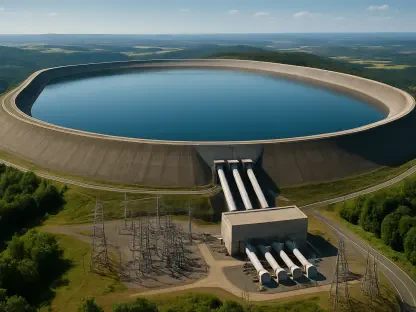The UK is at the forefront of adopting innovative renewable energy solutions, leading the global charge toward sustainable energy futures. Among the various renewable sources, tidal power stands out due to its predictability and potential for high energy output. Building on the success of existing tidal projects worldwide, the Mersey Tidal Power project aims to harness the power of the River Mersey’s tides, potentially generating up to one gigawatt (GW) of clean and renewable energy. However, this ambitious undertaking presents unique challenges in terms of electrical infrastructure, which must be addressed to ensure long-term stability, reliability, and durability.
The Predictability and Challenges of Tidal Energy
Predictability and Output Variations
The primary advantage of tidal power over other renewable energy sources lies in its predictability. Governed by the lunar cycle, tidal energy production can be more accurately forecasted than wind or solar energy. This predictability offers a level of stability that is highly desirable for grid management. Despite this advantage, tidal power generation is not without its complexities. The intensity of tidal flows varies, resulting in fluctuations in energy output that must be meticulously managed. These variations require advanced systems to ensure that energy production is efficient and that the flow of power to the grid remains steady.
Furthermore, the constant ebb and flow of tides mean that energy production is periodic, with peak outputs occurring at specific times. To prevent inefficiencies or disruptions in power transmission, engineers must design systems that can adapt to these cycles, capturing and storing energy effectively during peak production times and distributing it evenly when production levels are lower. This balancing act is crucial to maintaining both the reliability of the grid and the sustainability of the energy supply. Efficient management of these output variations ensures that tidal power can fulfill its promise as a stable and reliable renewable energy source.
Managing Electrical Infrastructure
Managing the electrical infrastructure to handle the unique demands of tidal energy production is essential for the success of projects like the Mersey Tidal Power project. The rapid and sometimes unpredictable changes in energy production due to tidal fluctuations can lead to power surges or dips. These surges and dips pose a risk to grid stability, as sudden increases or decreases in power can destabilize the network if not properly managed. Therefore, the infrastructure must be designed to accommodate these changes seamlessly, without compromising the reliability of the energy supply.
One of the critical aspects of managing tidal power generation is the integration of advanced control systems that can respond to variations quickly and efficiently. These systems must be capable of adjusting to rapid changes in energy production, smoothing out the delivery of power to prevent surges or deficits that could disrupt the grid. Additionally, the infrastructure must include robust components that can handle the physical demands of tidal energy generation. This includes ensuring that transformers, transmission lines, and other critical components can withstand the stresses imposed by variable energy production and the harsh marine environment in which they operate.
Ensuring Longevity in Marine Environments
Durability Requirements
The longevity of tidal power projects like the Mersey Tidal Power initiative is directly tied to the durability of their components. Designed for an operational lifespan exceeding 120 years, these projects must use electrical systems capable of enduring extreme marine conditions. The continuous exposure to saltwater, combined with high mechanical stresses from strong tidal currents, necessitates the use of materials and technologies that are both resistant and robust. Without such materials, the components would quickly degrade, leading to costly repairs and potential system failures.
Maintenance in such environments is complex and expensive, making durability a top priority for project designers. The use of highly resilient materials like marine-grade stainless steel and sheathed mineral-insulated elements helps ensure that components can withstand corrosion, heat, and mechanical wear. Comprehensive testing and engineering adaptations for marine applications are necessary to guarantee that every piece of the electrical system performs reliably over the long term. This ensures not only the sustainability of the energy supply but also the economic viability of large-scale tidal power projects.
Implementation of Dynamic Braking Resistors
Dynamic braking resistors (DBRs) are a crucial technology for maintaining grid stability and protecting the turbine infrastructure in tidal power projects. When tidal flows are at their peak, turbines generate more electricity than the grid can immediately use. DBRs are used to absorb this excess energy, converting it into heat and safely dissipating it. This process prevents voltage spikes that could overload transformers and other components of the electrical system. By doing so, DBRs help maintain a consistent and reliable supply of electricity, ensuring that tidal energy can be smoothly integrated into the wider grid.
Beyond their role in energy absorption, DBRs also contribute to the longevity of the turbine infrastructure. Rapid changes in tidal flow can cause sudden variations in torque on the turbine blades and drive systems, potentially leading to mechanical damage if not properly managed. DBRs help control the rotational speed of the turbines, reducing wear and tear on critical components like bearings and shafts. This mechanical stress management is vital for extending the lifespan of the turbines and enhancing the overall reliability of the tidal power system.
Technological Innovations for Marine Conditions
Turbine Infrastructure Preservation
Preserving turbine infrastructure in the harsh marine environment requires innovative solutions to manage the physical demands of tidal power generation. DBRs are instrumental in this effort, as they help mitigate the mechanical stresses caused by rapid changes in tidal flow. By controlling torque variations and rotational speeds, DBRs reduce the risk of damage to critical components, ensuring that turbines operate smoothly and efficiently. This preservation of infrastructure is essential for maintaining the long-term viability of tidal power projects and minimizing maintenance costs.
In addition to DBRs, other technological innovations are being implemented to enhance the durability and reliability of turbines. Advanced materials and coatings are being used to protect turbine blades and other components from corrosion and mechanical wear. Engineers are also developing new designs that minimize the impact of strong tidal currents and maximize energy capture. These innovations are crucial for ensuring that tidal power systems can withstand the harsh conditions of marine environments and continue to operate effectively over their long lifespans.
Resilient Materials
To withstand the extreme conditions of the marine environment, resistors used in tidal power systems must be made from resilient materials. Companies like Cressall specialize in manufacturing marine braking resistors designed to endure corrosion, heat, and mechanical wear. These resistors are constructed using high-quality materials such as sheathed mineral-insulated elements and marine-grade stainless steel. These materials provide protection against physical damage and environmental degradation, ensuring that the resistors maintain peak performance over the long term.
The use of these resilient materials is essential for the reliable operation of tidal power systems. By ensuring that the resistors can withstand the harsh marine conditions, engineers can guarantee that the electrical infrastructure remains robust and durable. This resilience is crucial for the long-term success of tidal power projects, as it reduces the need for frequent maintenance and replacements, ultimately saving costs and enhancing the overall sustainability of the energy supply.
Future Prospects for Tidal Power
Government Support and Strategic Goals
The UK government has shown growing support for tidal power as part of its long-term energy strategy. This support is crucial for the success of projects like the Mersey Tidal Power initiative, which has the potential to significantly contribute to the country’s renewable energy goals. The integration of resilient electrical components, such as DBRs, is vital for maintaining grid stability and ensuring the longevity of power generation systems. With the government’s backing, the Mersey Tidal Power project could pave the way for broader adoption of tidal infrastructure across the UK, further advancing the country’s renewable energy transition.
As the UK’s commitment to reducing carbon emissions and achieving net-zero targets continues, the successful implementation of tidal power projects will be essential. These projects not only provide a reliable source of clean energy but also demonstrate the country’s leadership in renewable energy innovation. By investing in and supporting tidal power, the UK can build a sustainable energy infrastructure that meets its long-term strategic goals while also setting an example for other nations.
Pioneering Renewable Energy
The UK is at the forefront of adopting cutting-edge renewable energy solutions, spearheading the global push towards sustainable energy futures. Among the diverse renewable sources, tidal power is remarkable for its predictability and high energy output potential. Leveraging the success of existing tidal projects worldwide, the Mersey Tidal Power project aims to capture the energy of the River Mersey’s tides, with the potential to generate up to one gigawatt (GW) of clean, renewable power. This ambitious endeavor, however, comes with unique challenges, particularly in terms of electrical infrastructure. Seamless integration and development of robust electrical systems are crucial to ensure the project’s long-term stability, reliability, and durability. The successful implementation of the Mersey Tidal Power project could set a precedent for future renewable energy undertakings, demonstrating the feasibility of large-scale tidal energy as a viable and reliable energy source for meeting global energy demands in a sustainable manner.









